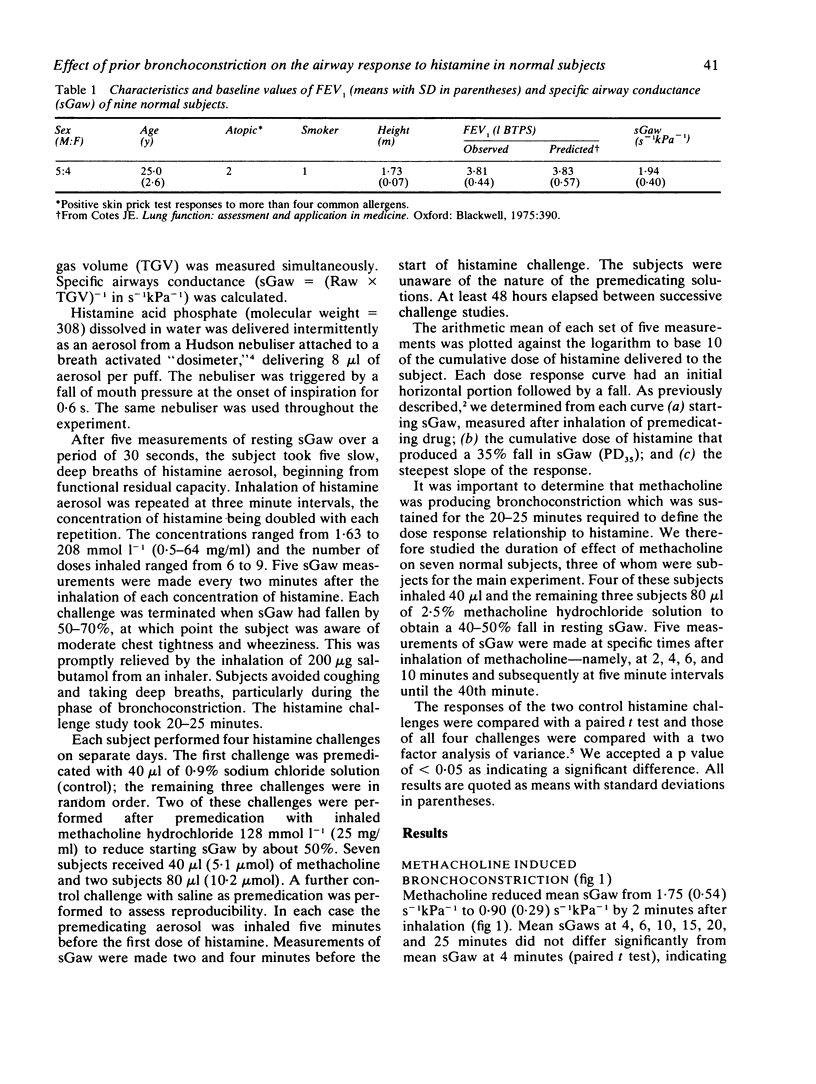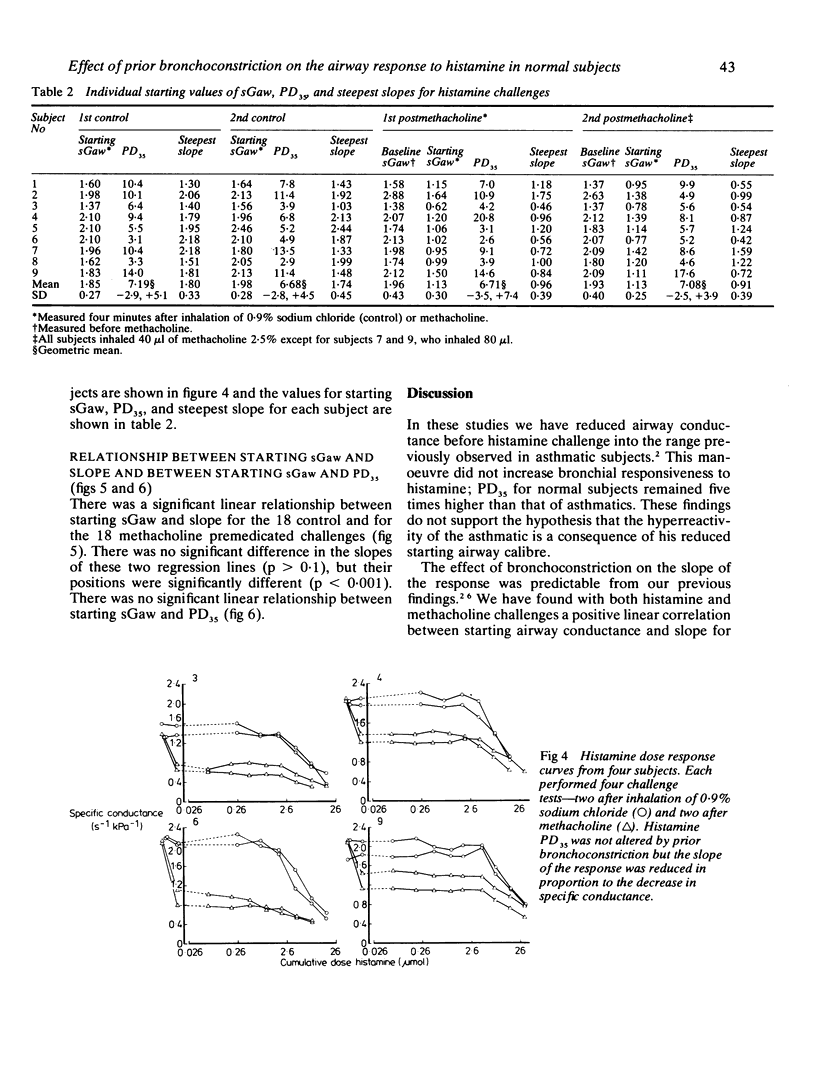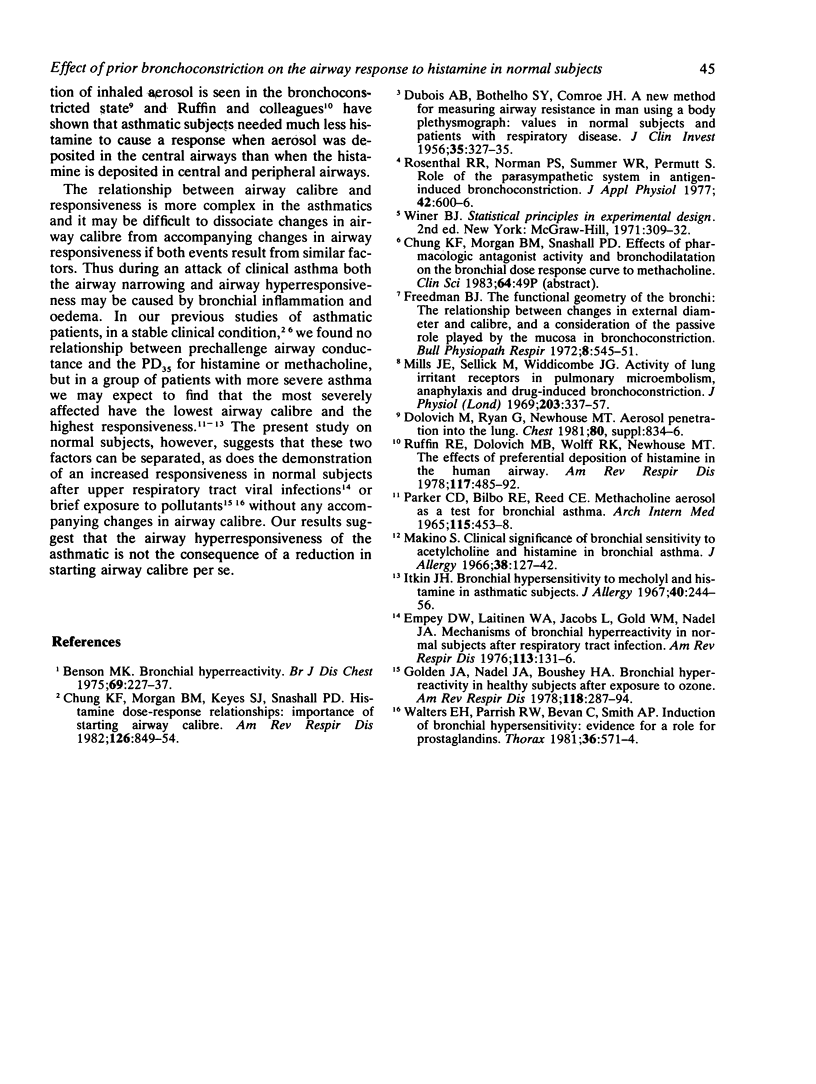Abstract
We have examined the effect of prior bronchoconstriction on the bronchial responsiveness to inhaled histamine in nine normal subjects. The airway response to increasing concentrations of histamine aerosol was assessed by measurement of specific airways conductance (sGaw) in a body plethysmograph. The threshold provocative dose of histamine needed to cause a 35% fall in starting sGaw (PD35) and the steepest slope of the response were measured from cumulative log dose response curves. Histamine challenges were performed in duplicate after premedication with 0.9% sodium chloride (control) or methacholine aerosol on separate days. The mean starting sGaw did not change significantly after inhalation of 0.9% sodium chloride but methacholine caused a mean reduction in sGaw of 42%. Mean control PD35 values did not differ significantly from mean PD35 values after methacholine. The mean steepest slope of the response after methacoline was 47% lower than the mean control value. There was a significant linear relationship between starting sGaw and the steepest slope for the control and for the methacholine premedicated challenges. The reduction in slope after methacholine was accounted for by the fall in starting sGaw. Because histamine PD35 was not altered by prior bronchoconstriction, it is concluded that the bronchial hyperresponsiveness of asthmatic subjects to non-specific bronchoconstrictor stimuli is unlikely to be a direct consequence of their low starting airway calibre.
Full text
PDF





Selected References
These references are in PubMed. This may not be the complete list of references from this article.
- Benson M. K. Bronchial hyperreactivity. Br J Dis Chest. 1975 Oct;69(0):227–239. doi: 10.1016/0007-0971(75)90090-x. [DOI] [PubMed] [Google Scholar]
- Chung K. F., Morgan B., Keyes S. J., Snashall P. D. Histamine dose-response relationships in normal and asthmatic subjects. The importance of starting airway caliber. Am Rev Respir Dis. 1982 Nov;126(5):849–854. doi: 10.1164/arrd.1982.126.5.849. [DOI] [PubMed] [Google Scholar]
- Corrall R. J., Frier B. M., Davidson N. M., Hopkins W. M., French E. B. Cholinergic manifestations of the acute autonomic reaction to hypoglycaemia in man. Clin Sci (Lond) 1983 Jan;64(1):49–53. doi: 10.1042/cs0640049. [DOI] [PubMed] [Google Scholar]
- DUBOIS A. B., BOTELHO S. Y., COMROE J. H., Jr A new method for measuring airway resistance in man using a body plethysmograph: values in normal subjects and in patients with respiratory disease. J Clin Invest. 1956 Mar;35(3):327–335. doi: 10.1172/JCI103282. [DOI] [PMC free article] [PubMed] [Google Scholar]
- Dolovich M., Ryan G., Newhouse M. T. Aerosol penetration into the lung; influence on airway responses. Chest. 1981 Dec;80(6 Suppl):834–836. [PubMed] [Google Scholar]
- Empey D. W., Laitinen L. A., Jacobs L., Gold W. M., Nadel J. A. Mechanisms of bronchial hyperreactivity in normal subjects after upper respiratory tract infection. Am Rev Respir Dis. 1976 Feb;113(2):131–139. doi: 10.1164/arrd.1976.113.2.131. [DOI] [PubMed] [Google Scholar]
- Freedman B. J. The functional geometry of the bronchi. The relationship between changes in external diameter and calibre, and a consideration of the passive role played by the mucosa in bronchoconstriction. Bull Physiopathol Respir (Nancy) 1972 May-Jun;8(3):545–552. [PubMed] [Google Scholar]
- Golden J. A., Nadel J. A., Boushey H. A. Bronchial hyperirritability in healthy subjects after exposure to ozone. Am Rev Respir Dis. 1978 Aug;118(2):287–294. doi: 10.1164/arrd.1978.118.2.287. [DOI] [PubMed] [Google Scholar]
- Makino S. Clinical significance of bronchial sensitivity to acetylcholine and histamine in bronchial asthma. J Allergy. 1966 Sep;38(3):127–142. doi: 10.1016/0021-8707(66)90036-0. [DOI] [PubMed] [Google Scholar]
- Mills J. E., Sellick H., Widdicombe J. G. Activity of lung irritant receptors in pulmonary microembolism, anaphylaxis and drug-induced bronchoconstrictions. J Physiol. 1969 Aug;203(2):337–357. doi: 10.1113/jphysiol.1969.sp008867. [DOI] [PMC free article] [PubMed] [Google Scholar]
- Rosenthal R. R., Norman P. S., Summer W. R., Permutt S. Role of the parasympathetic system in antigen-induced bronchospasm. J Appl Physiol Respir Environ Exerc Physiol. 1977 Apr;42(4):600–606. doi: 10.1152/jappl.1977.42.4.600. [DOI] [PubMed] [Google Scholar]
- Ruffin R. E., Dolovich M. B., Wolff R. K., Newhouse M. T. The effects of preferential deposition of histamine in the human airway. Am Rev Respir Dis. 1978 Mar;117(3):485–492. doi: 10.1164/arrd.1978.117.3.485. [DOI] [PubMed] [Google Scholar]
- Walters E. H., Parrish R. W., Bevan C., Smith A. P. Induction of bronchial hypersensitivity: evidence for a role for prostaglandins. Thorax. 1981 Aug;36(8):571–574. doi: 10.1136/thx.36.8.571. [DOI] [PMC free article] [PubMed] [Google Scholar]


